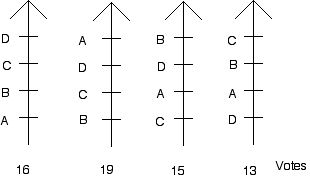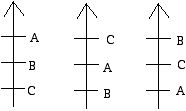
Elections: Practice Problems
Prepared by:
Joseph Malkevitch
Mathematics Department
York College (CUNY)
Jamaica, NY 11451
email:
malkevitch@york.cuny.edu
web page:
http://york.cuny.edu/~malk/
1. For the election below:

a. Find the winner using plurality
b. Find the winner using run-off
c. Find the winner using sequential run-off
d. Find the winner using Coombs
e. Find the winner, if there is one, using Condorcet
f. Find the winner using the Borda Count
g. Find the winner using a sequential run-off based on the Borda count
h. Suppose medial voting is defined as voting for the candidates who are at or above the medial level in a ballot. Who is the medial winner?
i. Suppose that one gives 10 points for a first place, 9 points for a second place, and 3 points for a 3rd place, and 1 point for a last place. Who wins using this system?
j. Write down the pairwise preference matrix for the election above.
k. The anti-plurality method chooses the candidate who got the fewest last place. Who is the anti-plurality winner for the election above. Do you think anti-plurality makes more or less sense as a method than plurality?
2. Can you find an example where there are only three candidates where the Borda Count, Coombs, and Condorcet methods yield different winners?
3. Given that each of the preference schedules below gets one vote:

a. Show that A can win with a sequence of pairwise votes
b. Show that B can win with a sequence of pairwise votes
c. Show that C can win with a sequence of pairwise votes
(Note: What is meant above is, for example, have an election between A and C and whoever wins is run against B.)
d. Construct the pairwise preference matrix for these ballots
4. List all of the different ballots that can be produced when there are three candidates and ties are allowed.
5. Write down an election involving a collection of ballots which ranks 4 candidates (U, Y, W, and X) and for which X beats Y in a two-way race, Y beats U in a two way race, U beats W in a two-way race, W beats X in a two-way race. Show that for this set of ballots it is possible to construct a sequence of pairwise races where at the end W emerges as the winner.